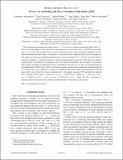| dc.contributor.author | Alexandrou, Constantia | |
| dc.contributor.author | Leskovec, Luka | |
| dc.contributor.author | Meinel, Stefan | |
| dc.contributor.author | Paul, Srijit | |
| dc.contributor.author | Petschlies, Marcus | |
| dc.contributor.author | Rendon, Gumaro | |
| dc.contributor.author | Syritsyn, Sergey | |
| dc.contributor.author | Pochinsky, Andrew | |
| dc.contributor.author | Negele, John W. | |
| dc.date.accessioned | 2018-12-04T15:47:52Z | |
| dc.date.available | 2018-12-04T15:47:52Z | |
| dc.date.issued | 2017-08 | |
| dc.date.submitted | 2017-04 | |
| dc.identifier.issn | 2470-0010 | |
| dc.identifier.issn | 2470-0029 | |
| dc.identifier.uri | http://hdl.handle.net/1721.1/119408 | |
| dc.description.abstract | We calculate the parameters describing elastic I=1, P-wave ππ scattering using lattice QCD with 2+1 flavors of clover fermions. Our calculation is performed with a pion mass of m[subscript π]≈320 MeV and a lattice size of L≈3.6 fm. We construct the two-point correlation matrices with both quark-antiquark and two-hadron interpolating fields using a combination of smeared forward, sequential and stochastic propagators. The spectra in all relevant irreducible representations for total momenta |P→|≤√3 2π/L are extracted with two alternative methods: a variational analysis as well as multiexponential matrix fits. We perform an analysis using Lüscher's formalism for the energies below the inelastic thresholds, and investigate several phase shift models, including possible nonresonant contributions. We find that our data are well described by the minimal Breit-Wigner form, with no statistically significant nonresonant component. In determining the ρ resonance mass and coupling we compare two different approaches: fitting the individually extracted phase shifts versus fitting the t-matrix model directly to the energy spectrum. We find that both methods give consistent results, and at a pion mass of am[subscript π]=0.18295(36)[subscript stat] obtain g[subscript ρππ]=5.69(13)[subscript stat](16)[subscript sys], am[subscript ρ]=0.4609(16)[subscript stat](14)[subscript sys], and a[subscript m[subscript ρ]]/am[subscript N]=0.7476(38)[subscript stat](23)[subscript sys], where the first uncertainty is statistical and the second is the systematic uncertainty due to the choice of fit ranges. | en_US |
| dc.description.sponsorship | United States. Department of Energy. Office of Nuclear Physics (Grant DE-SC0011090) | en_US |
| dc.description.sponsorship | United States. Department of Energy. Office of Nuclear Physics (Grant DE-FC02-06ER41444) | en_US |
| dc.description.sponsorship | Horizon 2020 Framework Programme (European Commission) (Marie SklodowskaCurie Grant 642069) | en_US |
| dc.relation.isversionof | http://dx.doi.org/10.1103/PhysRevD.96.034525 | en_US |
| dc.rights | Article is made available in accordance with the publisher's policy and may be subject to US copyright law. Please refer to the publisher's site for terms of use. | en_US |
| dc.source | APS | en_US |
| dc.title | P-Wave ππ Scattering and the ρ Resonance from Lattice QCD | en_US |
| dc.type | Article | en_US |
| dc.identifier.citation | Alexandrou, Constantia et al. “P-Wave ππ Scattering and the ρ Resonance from Lattice QCD.” Physical Review D 96, no. 3 (August 31, 2017). © 2017 American Physical Society | en_US |
| dc.contributor.department | Massachusetts Institute of Technology. Center for Theoretical Physics | en_US |
| dc.contributor.department | Massachusetts Institute of Technology. Department of Physics | en_US |
| dc.contributor.department | Massachusetts Institute of Technology. Laboratory for Nuclear Science | en_US |
| dc.contributor.mitauthor | Negele, John W | |
| dc.contributor.mitauthor | Pochinsky, Andrew | |
| dc.relation.journal | Physical Review D | en_US |
| dc.eprint.version | Final published version | en_US |
| dc.type.uri | http://purl.org/eprint/type/JournalArticle | en_US |
| eprint.status | http://purl.org/eprint/status/PeerReviewed | en_US |
| dc.date.updated | 2018-10-11T17:59:33Z | |
| dspace.orderedauthors | Alexandrou, Constantia; Leskovec, Luka; Meinel, Stefan; Negele, John; Paul, Srijit; Petschlies, Marcus; Pochinsky, Andrew; Rendon, Gumaro; Syritsyn, Sergey | en_US |
| dspace.embargo.terms | N | en_US |
| dc.identifier.orcid | https://orcid.org/0000-0002-5713-0039 | |
| mit.license | PUBLISHER_POLICY | en_US |
